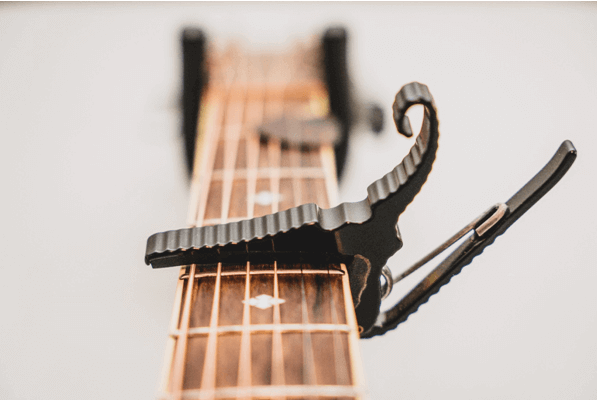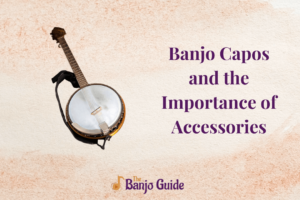Banjo capos have played an integral role in the evolution of bluegrass music. The banjo has been a consistent part of bluegrass bands and their unique sound.
Back then, the banjo was termed the key instrument in bluegrass bands. It is said to have shaped the bluegrass music genre. The application of banjo capos in bluegrass music further led to its evolution.
Banjo capos allow banjoists to explore different music genres within bluegrass. Such versatility allows bluegrass musicians to experiment with different sounds.
Banjo capos have contributed to the growth of bluegrass music. It has helped bluegrass musicians come up with innovative sounds for engaging audiences. It has helped them push the boundaries of traditional bluegrass music.
In this article, you will learn about banjo capos and the evolution of bluegrass music.
The article will reveal different types of banjo capos and their effects on sound. The article will also uncover famous bluegrass musicians, the impact of banjo capos on bluegrass music development, and tips and tricks for using a banjo capo.
How The Banjo Capo Transformed Bluegrass Music
The banjo capo has played a crucial role in the transformation of bluegrass. Using a banjo capo changes the key of the instrument. It allows banjoists to transpose their G-tuned banjos to different keys. Let’s learn how banjo capos have transformed bluegrass music:
- Banjos make it easy for musicians to play different configurations together. It offers them flexibility. It helps them adapt to the preferred key of other musicians conveniently.
- Banjos capos allow bluegrass musicians to explore. It helps play tunes written for other musical instruments. They won’t have to learn new tunings or finger positions. It allows you to tune your banjo with a capo.
- Banjo capos promote versatility among bluegrass musicians. It helps them broaden their music palette. Reaching a larger audience is also possible for this reason.
- Banjo Capos pushes the boundaries of traditional bluegrass music. It adds harmonic depth to enhance the overall music experience.
- Different banjo capo positions allow musicians to musicians to discover. It introduces them to new picking patterns, melodies, and chords. It improves their playing technique and expertise.
- Banjo capos help bluegrass musicians with composition and songwriting. The capo helps banjoists explore unique melodies and ideas.
The banjo capo continues to serve as an incredible tool for bluegrass musicians. It continues to play an essential role in the evolution of bluegrass music. Its impact is visible through the versatility and adaptability of banjo within bluegrass.
Exploring The Different Types Of Banjo Capos And Their Effects On Sound
There are many types of banjo capos out there. Each capo has its unique features. Some popular types of banjo capos and their effects on sound are discussed below:
- Lever-Action Capo: Lever-action capo or spring-loaded capo uses a lever mechanism. They are very easy to use. You can attach this capo by squeezing it. These capos might exert strong pressure on the strings. They help banjos produce a strong and vibrant tone.
- Strap-Style Capo: A strap-style capo consists of straps. These straps wrap around the neck of the banjo. These are versatile capos. They can fit different banjo neck shapes and sizes. They help banjos produce a consistent tone. They make sure the sound remains balanced.
- Sliding Capo: Sliding capos use a sliding mechanism. They can move up and down the banjo neck. They are a flexible choice. This capo needs to be adjusted constantly while playing. This can produce a subtle sliding sound. This can affect the desirability of a tone.
- Partial Capo: A partial capo only covers a banjo partially. It leaves some strings open. This capo is essential for producing unique sounds and tunings. Partial capos create rich yet complex harmonies. They are useful for open-string resonances and drones.
Famous Bluegrass Musicians Who Popularized The Use Of Banjo Capos
Many bluegrass musicians have popularised the use of banjo capos. Famous Bluegrass musicians who popularized the use of banjo capos are mentioned below:
- D. Crowe: J.D. Crowe is a famous bluegrass musician. Crowe has been an eminent figure in popularising the use of banjo capos in traditional bluegrass music. Crowe, along with his band, The New South, incorporated the elements of rock and country music into the genre. He used the banjo capos to add a dynamic element to his playability. He believed capos allowed him to seamlessly make key changes during his performances.
- Bela Fleck: Bela Fleck is another famous bluegrass musician who popularises the use of banjo capos. He performed multiple genres of music. However, his contributions to the contemporary bluegrass music genre are the most significant. He fearlessly explored the potential of the banjo with capos. He used alternate banjo capo positions for cross-genre collaborations. He inspired a new generation of bluegrass musicians altogether.
The Impact Of Banjo Capos On Bluegrass Music’s Development And Evolution
Banjo capos have had a huge impact on the development and evolution of bluegrass music. Some of the most elemental influences of banjo capos on bluegrass music are as follows:
- Traditional bluegrass music is based on the banjo G tuning. Using banjo capos allows musicians to make changes in the banjo key without retuning the banjo. This helps bluegrass musicians collaborate with different musicians. It helps them accommodate unique instrumental and vocal range preferences.
- Banjo capos allow banjoists to play different keys. Banjo capos help them push the technical boundaries of the playability of a banjo. It enables them to explore different melodic patterns. Banjoists can also learn new ways to approach the banjo as well as bluegrass banjo capo techniques. Banjo capos have certainly led to the development of advanced banjo playing styles and intricacy.
- Banjo capos have promoted the innovation of new arrangements in bluegrass music. Banjo capos allow banjoists to explore different positions and octaves on the banjo neck. It enables them to make new timbres. This has helped bluegrass musicians add more depth and complexity to the genre. It has added versatility to bluegrass music.
Tips And Tricks For Using A Banjo Capo In Your Own Playing
Using a banjo capo can help you uncover new banjo possibilities. Follow the below-mentioned tips and tricks for using a banjo capo to enhance your playability:
- You can try new banjo capo placements and banjo capo positions for different keys. It will help you understand what tonal effect suits your music capabilities the best.
- If you want your banjo to produce a bright and crisp sound, then place it closer to the fret. Place the banjo in the middle of the fret to produce a warm and mellow sound.
- You can use a banjo capo to transpose songs to different keys. You can try different banjo capo placements and positions to find the key that suits you best.
- You will not have to learn new chord shapes and patterns. You can use what you already know. Why? Because using a banjo capo, the chord shapes and patterns will produce a different sound.
- You can also use a partial banjo capo to find out new sonic landscapes. You can experiment with capos for different banjo types to produce unique harmonic textures.
FAQs
Is banjo music bluegrass?
Yes, Banjo music is considered bluegrass often but not all banjo music is bluegrass.
Banjo music has developed and revolutionized many music genres. It is said to be the foundation of bluegrass music. It has held an eminent place in the folk and bluegrass music genre since tradition.
What is the history of bluegrass music?
Bluegrass music has a rich history tracing back to the 20th century.
Bluegrass music was born post-World War 2. The roots of bluegrass music date back to the 1930s. It was named after the “The Blue Grass Boys” band.
Who is known as the father of bluegrass music?
William Smith Monroe is known as the father of bluegrass music. He was an eminent American singer, songwriter, and mandolist. He created the bluegrass music genre.




